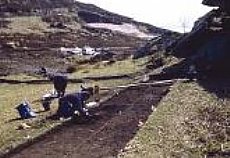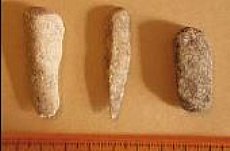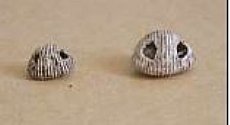Mesolithic Shell Midden at Sand, Wester Ross
03 September 2020
- News Type:
- Site of the Month

The excavated site at Sand is a rock shelter and midden on a small sandy bay to the north of Applecross, Wester Ross, investigated as part of Scotland’s First Settlers Project. Before the project, relatively few midden sites had been systematically excavated in Highland Region. Following testpitting in and around the rockshelter, a large trench was excavated in front of the rockshelter through a substantial shell midden, over 1 metre deep in places, and part of the adjacent terrace. There was no evidence of structured deposits within the midden.

Preservation at Sand was good, with all material sieved. No structural evidence was found, but a large number of artefacts dating from Mesolithic through into later periods including a Neolithic stone axe, Bronze Age arrowhead and human tooth, and Iron Age or later metalworking evidence and glass beads, as well as Medieval and later ceramics and glass. No archaeological evidence was obtained within the rockshelter, unlike many other similar sites investigated in the Scotlands First Settlers project, perhaps due to erosion or material having fallen down the slope.
Over 16,500 flaked stone pieces were recovered, with 39% of baked mudstone, 36% quartz/quartzite, 17% silica, 7.5% Rum bloodstone, 0.5% coarse stone. Most were found in the terrace in front of the rockshelter, rather than in the midden. The baked mudstone would have been obtained from Staffin, where chalcedonic silica is also common. With such a large dataset, it was possible to suggest some preferences by the knappers for certain raw materials for different types of objects. There were few bloodstone cores suggesting these objects arrived to Sand already complete. Further work on the lithic assemblage is possible, for example further investigation of knapping techniques or use-wear analysis. Around 40 coarse stone tools were also identified and analysed.

© Scotland's First Settlers Project
Over 50 bone tools were found, mostly bevel-ended tools but also including a fragment of a harpoon and possible knife, as well as antler tines with cut marks. It is probable bone tools were being made on site. Some were radiocarbon dated, producing dates in the 7th and 6th millennia BC. As part of the project, experimental work in production and wear of bevel-ended tools was undertaken, providing useful insights into Mesolithic bone production and use, and suggested the tools would have been effective for bark stripping and plant processing, and possibly used for hide working. While bevel-ended tools have traditionally been linked to shellfish processing, the experimental analysis showed this to be unlikely.
The generally good preservation provided a substantial sample of mammal, bird and fish remains, one of the largest assemblages for the Scottish Mesolithic, and an important assemblage as relatively few sites have such good preservation. These provide useful evidence of food and resource acquisition. 56 specimens have evidence of butchery or working. The assemblage shows a high degree of fragmentation, either the result of deliberate cultural activity such as preparation for tool production, or post-depositional activity. The bird remains provide evidence of seasonal activity. Fish were dominated by the wrasse and cod families, and size suggests inshore fishing. Shellfish was also abundant, especially limpets, periwinkles, dogwhelks mussels, as well as crabs, with uses including food, bait, decoration, raw material for tools, and/or in the case of dogwhelks, possibly as a source of dye. The analysis of shellfish raised a number of interesting questions on how to deal with huge numbers of finds.

© Scotland's First Settlers Project
A small assemblage of worked or decorative shells was also found at Sand, rare finds in the Scottish Mesolithic. Worked cowrie shells have been found at other sites in western Scotland. While certainly possible for decoration, ethnographic parallels show a wide range of uses for cowrie shells. A few deliberately cut scallop shells were also found.
Taken together the artefacts suggest a limited range of activities, and might even hint that some specialisation took place. For example, some lithic objects such as scalene triangle microliths or coarse stone tools are rare at Sand, although present at other Highland sites, suggesting that those who used this site were in need of other tools
Unlike many other midden sites which show multi-period activity, for example An Corran (MHG6497), the midden at Sand appears to be solely Mesolithic. Radiocarbon dating has shown that the midden dates mainly to the mid-late 7th millennium BC, contemporary with rockshelter/midden sites on Skye at An Corran (MHG6497) and Loch a Sguirr, Raasay (MHG58707) and the open midden at Camas Daraich (MHG36657), as well as the settlement site of Kinloch, Rum (MHG3987) and the middens at Tarradale, Easter Ross (Grant 2020). Sand is one of the earliest midden sites in Scotland. There was then a gap of around 1000 years. Two dates showing mid 6th millennium activity in the Mesolithic period show some reuse at this time, interestingly in an area without midden deposits. A ground stone axe was found in this general area, and would suggest either later Neolithic activity in this part of the site, or a longer chronological span than is generally acknowledged for ground axes.
The fact that the midden does not have later period remains makes it particularly useful for investigations of the Mesolithic period. Middens are also relatively rare for the Scottish Mesolithic. It is also noteworthy that the rich potential of the site was not visible before excavation.
Further information
Highland HER MHG35892
Hardy, Karen and Wickham-Jones, Caroline (eds) 2009 ‘Mesolithic and later sites around the Inner Sound, Scotland: the work of the Scotland’s First Settlers project 1998-2004’, Scottish Archaeological Internet Reports 31. (Site SFS 4) A variety of specialist reports include:
Hardy, Karen ‘3.2 Excavation at Sand, rockshelter’
Ashmore, Patrick and Wickham-Jones, Caroline ‘4 Radiocarbon determinations in context'
Birch, Steven ‘3.4.4 The Production and Use of Bone Bevel Ended Tools’
Milner, Nicky ‘3.12 Mesolithic middens and marine molluscs, procurement and consumption of shellfish at the site of Sand'
Milner, Nicky ‘3.13 Consumption of crabs in the Mesolithic: side stepping the evidence’, in Hardy and Wickham-Jones 2009
Parks, Rachel and Barrett, James ‘3.11 The zooarchaeology of Sand’
Wickham-Jones Caroline R ‘5 Lithic raw material use around the Inner Sound’
Site of the Month Archive
- 10/04/2021 Easter Raitts township
- 02/03/2021 Lower Slackbuie, Inverness (ASDA) Neolithic site
- 01/02/2021 Balnuaran of Clava cairns
- 04/01/2021 Wilkhouse Inn
- 02/12/2020 Spinningdale Cotton Mill
- 02/11/2020 Skibo A Canadian Forestry Camp
- 01/10/2020 WWI Detonator Store, Dalmore near Invergordon
- 03/09/2020 Mesolithic Shell Midden at Sand, Wester Ross
- 08/08/2020 Kinbeachie Neolithic settlement
- 01/07/2020 Armadale Cist Burial and Stone & Timber Complex
